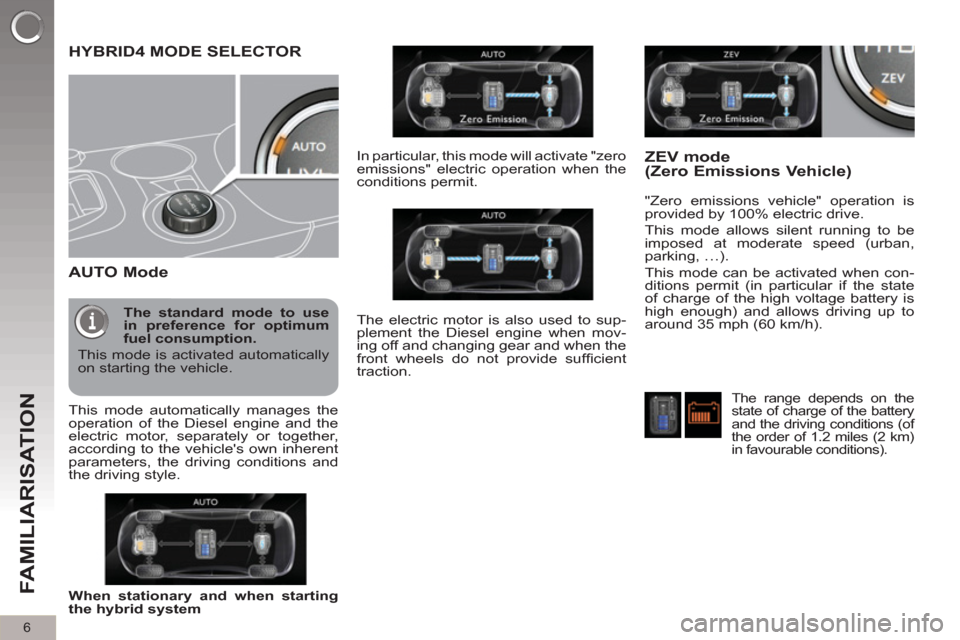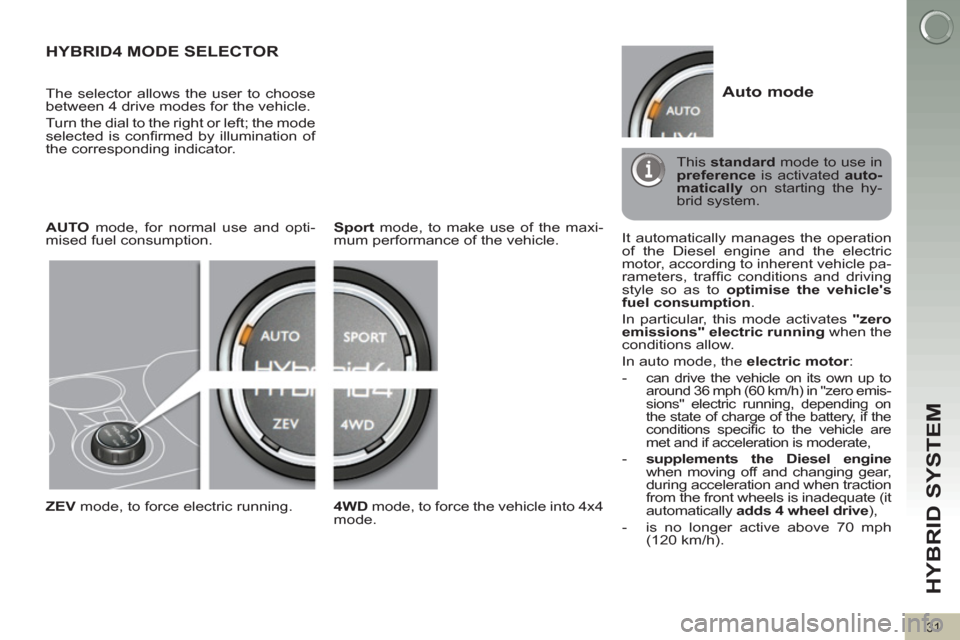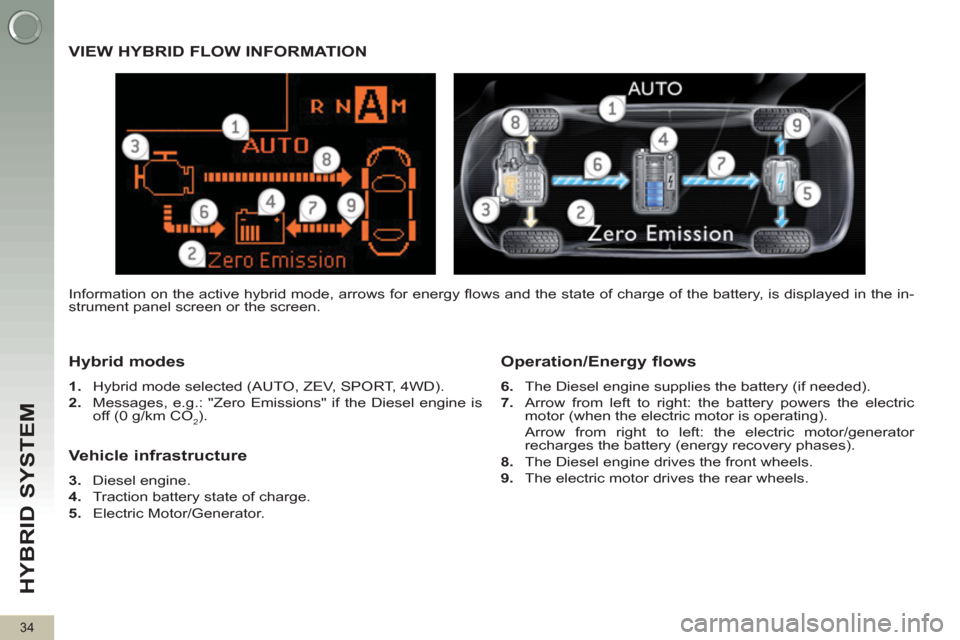2012 Peugeot 3008 Hybrid 4 Traction
[x] Cancel search: TractionPage 8 of 284

6
FAMILIARISATION
HYBRID4 MODE SELECTOR
AUTO Mode
"Zero emissions vehicle" operation is
provided by 100% electric drive.
This mode allows silent running to be
imposed at moderate speed (urban,
parking, …).
This mode can be activated when con-
ditions permit (in particular if the state
of charge of the high voltage battery is
high enough) and allows driving up to
around 35 mph (60 km/h).
ZEV mode
(Zero Emissions Vehicle)
When stationary and when starting
the hybrid system
This mode automatically manages the
operation of the Diesel engine and the
electric motor, separately or together,
according to the vehicle's own inherent
parameters, the driving conditions and
the driving style.
The standard mode to use
in preference for optimum
fuel consumption.
This mode is activated automatically
on starting the vehicle.
In particular, this mode will activate "zero
emissions" electric operation when the
conditions permit.
The electric motor is also used to sup-
plement the Diesel engine when mov-
ing off and changing gear and when the
front wheels do not provide suffi cient
traction.
The range depends on the
state of charge of the battery
and the driving conditions (of
the order of 1.2 miles (2 km)
in favourable conditions).
Page 9 of 284

7
FAMILIARISATION
Displays according to version in the
instrument panel screen or the main
screen.
This mode allows a more dynamic driving
style providing increased performance.
Acceleration and pickup are maximised
using the full capacity of the electric motor
to supplement the Diesel engine.
The Stop & Start system also operates
in this mode.
This mode provides improved traction.
The Diesel engine drives the front
wheels continuously and the electric
motor drives the rear wheels.
Their coupling is managed automati-
cally to optimise traction on slippery
surfaces. This mode should be used on
snow covered roads and diffi cult ground
(mud, sand, …).
Sport mode
4WD mode
(4 wheel drive)
Page 33 of 284

HYBRID SYSTEM
31
HYBRID4 MODE SELECTOR
The selector allows the user to choose
between 4 drive modes for the vehicle.
Turn the dial to the right or left; the mode
selected is confi rmed by illumination of
the corresponding indicator.
ZEV
mode, to force electric running.
Sport
mode, to make use of the maxi-
mum performance of the vehicle.
Auto mode
4WD
mode, to force the vehicle into 4x4
mode.
It automatically manages the operation
of the Diesel engine and the electric
motor, according to inherent vehicle pa-
rameters, traffi c conditions and driving
style so as to optimise the vehicle's
fuel consumption
.
In particular, this mode activates "zero
emissions" electric running
when the
conditions allow.
In auto mode, the electric motor
:
-
can drive the vehicle on its own up to
around 36 mph (60 km/h) in "zero emis-
sions" electric running, depending on
the state of charge of the battery, if the
conditions specifi c to the vehicle are
met and if acceleration is moderate,
- supplements the Diesel engine
when moving off and changing gear,
during acceleration and when traction
from the front wheels is inadequate (it
automatically adds
4 wheel drive
),
- is no longer active above 70 mph
(120 km/h).
AUTO
mode, for normal use and opti-
mised fuel consumption.
This standard
mode to use in
preference
is activated auto-
matically
on starting the hy-
brid system.
Page 34 of 284

HYBRID SYSTEM
32
ZEV mode *
(all electric)
Sport mode
(Diesel and
electric)
4WD mode **
(Diesel and
electric)
Zero emissions vehicle operation is as-
sured 100 % by electric drive.
This mode forces silent running
at
moderate speeds.
This mode allows more dynamic driving
by providing additional performance
.
Vehicle acceleration and pick-up are
maximised by using the capacity of the
electric motor, supplementing the power
of the Diesel engine.
This mode manages the progressive-
ness of the accelerator, the automatic
gear control gearbox and the use of the
electric motor.
In Sport mode:
- The electric motor can be used up to
70 mph (120 km/h).
This mode provides additional traction
***
at low speed by driving all 4 wheels of the
vehicle continuously: the Diesel engine
(front wheel drive) and the electric motor
(rear wheel drive) operate simultaneously
and permanently.
Their coupling is managed electroni-
cally to optimise traction on slippery
surfaces.
In 4WD mode:
- Power for the electric motor is
provided, if needed, by the alterna-
tor-starter motor of the front engine.
The Diesel engine operates continu-
ously.
- The additional traction from the elec-
tric motor is available up to 70 mph
(120 km/h).
*
ZEV: Zero Emissions Vehicle. In ZEV mode:
- the accelerator control is progres-
sive.
-
Range and acceleration capacity are
limited. The maximum speed possible
is around 36 mph (60 km/h).
- Under high load or a priority require-
ment causing the start of the Diesel
engine, the system changes auto-
matically to AUTO mode.
It can be activated when
the required conditions are
met, particularly if the state
of charge of high voltage
battery is suffi cient (4 bars minimum).
If the conditions do not allow
this mode, a message that the
ZEV mode is not available ap-
pears in the screen, the ZEV
warning lamp fl ashes for a few
seconds then goes off and the selector
comes on in AUTO.
**
4WD: 4 Wheel Drive.
***
This mode will be even more effec-
tive if suitable tyres are fi tted (winter
tyres in particular).
This mode should be used on
snow covered roads or diffi cult
ground (mud, sand, …).
Page 36 of 284

HYBRID SYSTEM
34
VIEW HYBRID FLOW INFORMATION
Hybrid modes
1.
Hybrid mode selected (AUTO, ZEV, SPORT, 4WD).
2.
Messages, e.g.: "Zero Emissions" if the Diesel engine is
off (0 g/km CO
2).
Operation/Energy flows
6.
The Diesel engine supplies the battery (if needed).
7.
Arrow from left to right: the battery powers the electric
motor (when the electric motor is operating).
Arrow from right to left: the electric motor/generator
recharges the battery (energy recovery phases).
8.
The Diesel engine drives the front wheels.
9.
The electric motor drives the rear wheels.
Vehicle infrastructure
3.
Diesel engine.
4.
Traction battery state of charge.
5.
Electric Motor/Generator. Information on the active hybrid mode, arrows for energy fl ows and the state of charge of the battery, is displayed in the in-
strument panel screen or the screen.
Page 54 of 284

52
INSTRUMENTS and CONTROLS
Warning lamp
is on
Cause
Action/Observations
Engine
autodiagnosis
system
fl ashing. The engine management
system has a fault.
Risk of destruction of the catalytic converter.
Have it checked by a PEUGEOT dealer or
a qualifi ed workshop.
fi xed. The emission control system
has a fault. The warning lamp should go off when the
engine is started.
If it does not go off, contact a PEUGEOT
dealer or qualifi ed workshop without delay.
Low fuel
level
fi xed with the needle
in the red zone. When it fi rst comes on there
remains approximately
6 litres
of fuel in the tank.
At this point, you begin to
use the fuel reserve.
Refuel as soon as possible to avoid
running out of fuel.
This warning lamp will come on every time
the ignition is switched on, until a suffi cient
addition of fuel is made.
Fuel tank capacity: approximately 56.5 litres
.
Never continue to drive until you run out of fuel, as this
could damage the emission control and injection systems.
Maximum
coolant
temperature
fi xed with the needle
in the red zone. The temperature of the
cooling system is too high. Stop as soon as it is safe to do so.
Wait until the engine has cooled down
before topping up the level, if necessary.
If the problem persists, contact a PEUGEOT
dealer or a qualifi ed workshop.
Dynamic
stability
control
(DSC/ASR)
fl ashing. The DSC/ASR regulation is
active. The system optimises traction and improves
the directional stability of the vehicle.
fi xed. Unless it has been
deactivated (button pressed
and its indicator lamp on) the
DSC/ASR system has a fault. Have it checked by a PEUGEOT or a
qualifi ed workshop.
Anti-lock
Braking
System
(ABS)
fi xed. The anti-lock braking system
has a fault. The vehicle retains conventional
braking.
Drive carefully at reduced speed
and contact a PEUGEOT dealer or a
qualifi ed workshop without delay.
Page 132 of 284

SAFETY
130
ELECTRONIC STABILITY
PROGRAMME (ESC)
Electronic Stability Programme (ESC:
Electronic Stability Control) incorporating
the following systems:
- the anti-lock braking system (ABS)
and the electronic brake force distri-
bution (EBFD),
- the emergency braking assistance,
- the anti-slip regulation (ASR) or
traction control,
- the dynamic stability control (DSC).
Definitions
Anti-skid regulation (ASR)
The ASR system (also known as Trac-
tion Control) optimises traction in order
to avoid wheel slip by acting on the
brakes of the driving wheels and on the
engine. It also improves the directional
stability of the vehicle on acceleration.
Dynamic stability control (DSC)
If there is a difference between the path
followed by the vehicle and that re-
quired by the driver, the DSC monitors
each wheel and automatically acts on
the brake of one or more wheels and
on the engine to return the vehicle to
the required path, within the limits of the
laws of physics.
Emergency braking assistance
In an emergency, this system enables
you to reach the optimum braking pres-
sure more quickly and therefore reduce
the stopping distance.
It is triggered in relation to the speed at
which the brake pedal is pressed. This
is felt by a reduction in the resistance of
the pedal and an increase in the effec-
tiveness of the braking.
Anti-lock braking system (ABS) and
electronic brake force distribution
(EBFD)
This system improves the stability and
manoeuvrability of your vehicle when
braking and offers improved control in
corners, in particular on poor or slippery
road surfaces.
The ABS prevents wheel lock in the
event of emergency braking.
The electronic brake force distribution
system manages the braking pressure
wheel by wheel.
Operation
When this warning lamp comes
on, accompanied by an audible
signal and a message, it indi-
cates that there is a fault with
the ABS, which could cause loss of con-
trol of the vehicle when braking.
When this warning lamp comes
on, coupled with the STOP
warning lamp, accompanied
by an audible signal and a
message, it indicates that there is a fault
with the electronic brake force distribu-
tion (EBFD), which could cause loss of
control of the vehicle when braking.
You must stop as soon as it is safe
to do so.
In both cases, contact a PEUGEOT
dealer or a qualifi ed workshop.
When changing wheels (tyres
and rims), make sure that
these are approved for your
vehicle.
Normal operation of the ABS may
make itself felt by slight vibrations of
the brake pedal.
In emergency braking, press
very fi rmly without releasing
the pressure.
Anti-lock braking system (ABS) and
electronic brake force distribution
(EBFD)
Page 181 of 284

PRACTICAL INFORMATION
179
CHANGING A FUSE
Procedure for replacing a faulty fuse
with a new fuse to rectify a failure of the
corresponding function.
Access to the tools
The fuse extraction tweezer is fi tted
to the back of the dashboard fusebox
cover.
To gain access to it:
�)
remove the cover completely,
�)
remove the tweezer.
Changing a fuse
Before changing a fuse, the cause of
the failure must be identifi ed and recti-
fi ed.
�)
Identify the faulty fuse by checking
the condition of its fi lament.
Good
Failed
�)
Use the special tweezer to extract
the fuse from its housing.
�)
Always replace the faulty fuse with a
fuse of the same rating.
�)
Check that the number etched on
the box, the rating etched on the
fuse and the tables below all agree.
Installing electrical
accessories
Your vehicle's electrical sys-
tem is designed to operate with stan-
dard or optional equipment.
Before installing other electrical
equipment or accessories on your
vehicle, contact a PEUGEOT dealer.
PEUGEOT will not accept
responsibility for the cost in-
curred in repairing your ve-
hicle or for rectifying malfunctions
resulting from the installation of ac-
cessories not supplied and not rec-
ommended by PEUGEOT and not
installed in accordance with its in-
structions, in particular when the
combined consumption of all of the
additional equipment connected ex-
ceeds 10 milliamperes.